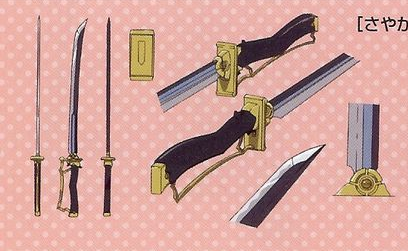
Primary Magic: Tempest Notes
Secondary Magic: N/A
Caster or Holder: Holder
- Description:
- The Tempest Notes are generally a collection of ancient songs sung by the 'heartstrings' of beings or souls. They contain natural magical energy fueled by the raw emotional power of these otherworldly notes. Simply put, they are the stories of the ancients, be it human or beast, collectively formed into a song represented by various notes of different intensity, form and tempo. Using these notes, the conductors, or those who practice The Tempest Notes, can utilize the songs' given elements: Water being its primary element, Wind being its partner element, and Lightning being occasionally present in some songs; all coming down to a formation of storms.
This kind of magic first materializes the song in a series of given notes, the power depending on the point of the song. The notes are formed entirely from crystal blue water. At the user's command, the notes can generate torrents of water of incredible power, they can also generate rain if they wish to do so. They are not limited to merely torrents, but can also generate floods and use water offensively and defensively in numerous ways. Gales and hurricanes can be also formed as a complimentary element, commonly appearing in higher-ranked chords and progressions, but still present at lower ranks somewhat. Lightning can be also present as a primary stun tactic at higher ranks. When all three elements are present, the song is considered a perfect tempest. Perfect Tempests are often harder to control, but are very destructive and can do tons of damage to a wide area accordingly.Each song even has it own special effect. Depending on the chord ( a group of notes )played, or part played, the effect may have a larger effect. Considering that it is a music based, so long as the song is heard, then the effect is applied.
But the tempest muses also have developed a way to use water for its more natural ways. Healing, primarily, became a wild sensation amongst the branches of the Note practitioners, that it is considered the best aspect of the Tempest Notes. With the right songs and timings, the tempest can easily heal light to heavy wounds. Although they cannot regenerate limbs or resurrect people, and that in particular is a taboo for the muses who believe in life after death.
Although some may consider it songs of the dead, they are more of the thoughts and emotions those souls left behind before their death. The Tempest Notes is merely a branch of a larger, and grander collection of songs of the ancients gathered by awakened bards from long ago, all who have learned to listen to the whispers of life and had transformed them into songs and notes.
Nowadays, it's harder to create a new tempest song due to the foreign noises that filter out the sounds of the souls of those heartstrings. It takes a lot of dedication to truly understand the soul of something and recreate it in the most accurate way possible, to achieve the best effects.
A muse is the given name for an official practitioner. When the practitioner is a male, he is called a maestro. Collectively, they are called conductors. Similar to an orchestra, the conductors control the flow of the notes and give them life with their baton. Their baton is a heavenly sword formed from the first few heartstrings of a mage. It is made by their masters, and given to the apprentice after they have fully memorized their first song. The baton is a special object that enables them to cast the notes freely as they please, without the baton, they are not capable of controlling it.
Luckily, the baton is not something that can be so easily destroyed. For the Tempest Notes, when their baton is grasped by someone other than the muse or conductor, their sword melts into ordinary water, no longer of use until the original conductor/muse sings the first notes their heartstrings made when it was given to them.
It's full name is Polymnia Ron-Octavias (which means "The Very Melodic and Joyful Singing Octavias"). Mairin prefers to refer to it as "Octavia" because she believes it's a girl, plus it's shorter. Octavia is in the form of a cutlass. She is Mairin's special baton fused from the first few heartstrings her master located during a special awakening spell. It resembles a cutlass with a special golden hilt and a golden handle with a brass curve over it, as to prevent it from falling off of Mairin's hand. When it is being used to conduct, it turns a sharp blue color, similar to that of her eyes. When used to attack, the blue color eventually disappears.
The baton can be utilized as well. Given it is in the form of a sword, it is generally used like other swords. When out of battle, Octavia is generally unable to cut things normally because her blade is dulled. But in battle where the Tempest Notes are conducted, Octavia will gain a sharpness that will deal damage equal to the rank of the current chord being played. (D-rank chord -> D-rank Damage) This only means that Octavia does not have a set damage outside the usage of the notes.
The user and her baton are one of the same. But it can be easily fragmented to form dozens upon thousands of copies for battle purposes. Each copy is limited to half the damage of the chord water it was forged from (D-rank chord/song -> Half D-rank damage for each copy). The batons each have their own special design and feature that enhances particular songs and effects. For Mairin, that kind of feature is unknown to her still, because of her lack of training and proper understanding of her baton.
The Tempest Notes do not need a source to function. They have an innate, limited source of water that represents the various sorrows and tears that fill parts of the songs. The more sorrowful the song, the more water is generated, and the destruction aspect of it is sharpened and enhanced. The lesser the sorrow, the greater the healing effect, but only a minimal amount of water is generated.
The Tempest Notes, given the fact that they are initially limitless in terms of resource, can be utilized as a form of transport. The user can generate large waves and push ships faster, or form bubbles of water to float light objects away. With enough practice, the user can even ride these forms without a vehicle. Mairin is told she needs to understand the songs better, and give much importance to her baton and how it's 'part' of her. So far her training has proved her unsuccessful. With time, perhaps.
- Strengths:
- Diversity:
- Despite being bound to the elements of water, wind, and lightning, the notes themselves have various effects carried by their emotional power. This is a large advantage since the elements themselves aren't particularly destructive in minimal amounts. In addition, these elements is entirely flexible and with the help of their batons, can be used in many ways. - Song Duration and Performances:
- Each conductor can learn many songs. But the fact that each song is separated into parts, playing the song parts as they are meant to be as an entire song creates a performance. A performance is the complete form of the song, the entire tempest. Some songs may start off weak, but when it reaches its climax, they may begin to create floods and destructive waves. When the muses/conductors play them fluidly and continuously, it increases the effects of the song, along with the sharpness of their sword batons. The forms of each song is made so as a a way to use the batons to their fullest, as in, the users can use the way they conduct their baton as attacks. (e.g. a horizantal chord is a horizontal slash, damage equivalent to the same rank of the chord). - The Functions of Batons:
- The Tempest Muses were known for their creative use of their batons. They may not copy their batons exactly, but given the flexibility of their element, they may easily transform their waters into copies of their batons. Even if they aren't as sharp as the original baton, they are somewhat useful in providing extra damage (at least half the damage of the spell water it was forged from). When spell water is made into a baton, the spell's initial attack is cancelled, but the song keeps playing.
- Diversity:
- - - -
- Weaknesses:
- Interruption:
- A conductor must not be interrupted when conducting a tempest. This disrupts the flow of the chords and notes and eventually destroys the build up of the climax, the highest and strongest part of the song. Without proper training, apprentices may not be able to defend themselves while they conduct. It is possible to push up barriers for incoming attacks from blind sides, but it's incredibly complex and must use two batons and conduct two songs at the same time. - Time, Energy and Focus
- Some songs tend to drag on, and this makes the battle longer. This can tire out the conductors and may affect their performance. They must be prepared to face the consequences of long and straining arm movements whilst trying to become one with the tempest, understanding the emotion of the song and sympathizing with their sorrows and joys to actually achieve the best of it can offer. Failure to comply to these may result into a distorted performance or a "Dissonance", an imperfect performance that not only decreases the song's effectiveness, but also puts a grudge from the deceased soul on the muses/conductors heads that will affect their next performance, giving more chances to distortion if not played correctly. The only way to erase the grudge is to play the song correctly for a second time. - Chord Intermissions
- Some songs have chord intermissions. It's a point where a conductor's defense temporarily lowers due to fatigue, and uses their energy to fuel the intermission. With enough energy, the intermission may even surpass the climax. However, for a few chords (5 in particular for mages under A rank, only 3 or less for A ranks and above) after the intermission, the conductor is considered a glass cannon, and may be susceptible to ambushes and interruptions. There are ways to avoid this, like barriers and avoiding the songs with these kinds of chords. But since some of the songs that have intermissions are relatively powerful, the muses/conductors prefer to include them in their performance regardless. - The Absence of the Baton
- When a conductor drops his/her baton, the performance ceases. It's the same case for when the baton is stolen or the baton is tossed from the muse's hands. This wastes the effort of building up the climax and energy and time since the muse has to sing the baton's special song before they can resume conducting.
- Interruption:
- - - -
- Lineage:
- Time Keeper's Curse:
Description: Since the beginning, there has always been one to control and rule the delicate realm of time. There they would stay, watching over every clock to make sure everything stays on scheduled. However, the task of guarding time is a burden beyond any single person's control; despite being immortal. Driving each keeper mad, the task has been passed down from generation upon generation; each one a new Keeper of time is chosen. Though they inherit the powers of the Time Keeper, it is not until they have fully matured, do they inherit the responsibility of watching over time till they find the next replacement.
Ability: The Time Keeper is able to slow down or speed up time and even able to stop time in it's tracks; being unaffected by their own magic.
Usage: Slowing town or Speeding up time takes a large amount of power, quickly draining the user of their magical power, each lasting for one post. Stopping time drains the user of all their magical power and lasts until user's next post. Time can be slowed, or sped up only three times per thread, and can only be stopped once. While slowing down, speeding up, or stopping time; the user is unable to use any other spells due to the massive amount of focus for each.
- - - -
- Unique Abilities:
The Ability to Utilize More than One Element
- Tempests are violent storms, and as such, the ancients who were the pioneers of the Tempest Notes gave it it's name for the songs' ability to not only use the element water as its primary source, but also use the winds and the lightning that is generated during a common Tempest. Water represents the tears of a soul, how much sorrow and sadness they had undergone before their death. Wind represents the trials that continued to push the souls, evidently pushing them to the grave. Lightning represents the anger, and the fleeting thoughts of revenge and hostility for the world before they died. With all of this, the conductor has a wide range of choices.
- - - -
The Ability to Create Copies of Itself
- Octavia can use chord water to generate copies of itself to attack instead of the water. To distinguish the original over the copies, one must notice subtle differences such as the color of the handle (black -> white) and the hilt's design (circle -> diamond). The muse can use this ability in numerous ways. The maximum no. of copies it can make is 5 at it's current rank (D rank). This adds another 5 copies for each rank up. Each copy only deals half the amount of the song/chord it was made from.
- - - -
The Ability to Reduce Itself into Water and Back Into a Sword
- When hit by something Octavia can't handle, it'll turn into water so it can protect itself from breaking. When stolen, Octavia will reduce itself into water to avoid being used by other conductors. Octavia cannot be remade so it does this to make sure it does not need fixing. It's an innate ability for all the batons, and therefor Octavia cannot be broken, because without it, Mairin would not be able to conduct. The only way for Octavia to be broken and to never again be used is when Mairin dies. The special song to bring it back into a sword is:
"The gleeful sky and brightest waves are smiling at me;
And because of that, I shall serve thee--
Child of the stars and sea."
Octavia will only automatically become a sword in Mairin's hand. When the song travels through the air, the water that was previously Octavia homes in on Mairin's singing voice and travels through the sky towards her regardless of the location. The water travels at a speed of 10 kilometers per hour. Octavia degenerates into ordinary water, not a sword made of water. When ordinary water is held, it slips through your fingers and splats all over the floor or whatever, and that's Octavia's defense mechanism. When it travels, the water becomes droplets and they rush over towards Mairin.
Spells:
- D rank:

Name: The Love-Lost Ballad of Eumeleia: The First Chord
Also Referred to as: The Fool's First Chord
Rank: D
Type: Water, Defensive
Duration: 1 post
Cooldown: 2 posts
Description:An old fisherman's tale of a mermaid's lost love. The Love Lost Ballad is a common practice song for beginning conductors for it's straightforwardness and easy pitches and tempo. It's form is not particularly beautiful or artistic, but it gets the job done.
As it is only the prelude, it only equates to Eumeleia's frustration and envy directed towards the humans who have far more interesting lives than her's in the sea. It's a dull tone that starts off at a low key.
The spell is cast when Mairin raises both her hands, the baton in her dominant left hand, and her other vacant. As it starts off without much dynamo, she only needs to raise her hands up with a slightly jagged motion and end with a very agitated and dramatic drop. This movement creates five small magic circles (about one palm in total circumference, 2 meters in line measure, 3 meters away from the muse) in front of the user in a vertical line. The downward motion activates all of the circles and makes them push a powerful stream of water capable of delaying moving targets with it's dull, slowing effect that is generated by the notes and the water. It does not have any damage and can only affect lower ranked mobs or mages the same rank as the muse.
Strengths:- This chord is an independent chord, meaning the user can leave it to play even if the user has bolted away from the cluster of chords. The chord plays for about 10 seconds (1 post) This gives the user time to escape from charging enemies.
- It's easy to play as a single chord, and even easier to conduct for the entire performance of the Love-Lost Ballad.
- The user can cast this while she runs with enough focus. When the circles appear behind her while the muse is facing the other way, it becomes a key. In this prelude, the chord becomes the Key of F(rustration). Although it has less power, it's enough to slow down low ranked mobs significantly.
Weaknesses:- It does not do any damage, as it does not even increase the sharpness of the muse's baton.
- It's useless against higher ranked mages.
- Avoidable due to its vertical area and mediocre range.
- Single-target.
- - - -
Name: Calandra Cadens: The First Chord
Also Referred to As: The Fool's First Power Chord, The First Foolish Fall of Calandra
Rank: D
Type: Water, Offensive
Duration: 2 posts
Cooldown: 3 posts
Description:A tragic tale of caused by foolishness and misconceptions, Calandra Cadens is an easy power chord for first time muses. A power chord is a series of notes that exert great force for a short amount of time, however it's effects are often weak and are not all that accurate. They are quick, and mostly need one swift motion to fully play. This power chord in particular only needs one diagonal cut (1 meter in length) from the muse's baton, signifying the dramatic birth of Calandra and the uproar of violins that signify the curse placed by the witch on Calandra at her cradle.
When the muse does so, five palm-sized circles trace out the line made by the muse's baton. Then it releases a large blasting impact of water that slams the target into any colliding object behind it (a total range of 5 meters away from the muse). The pushing force is so great for it's rank of spell that it totals to one and a half D-rank damage in total.
The blast is exactly one minute long (1 post), meaning it keeps the target where it had collided for a while, before inducing it's dizzying effect on the target. The target will remain shaking uncontrollably and will continue to feel dizzy, similar to being fatigued or afraid, for at least 3 minutes (1 post) before the effects disappear. This renders the target unable to move due to the loss of balance.
Strengths:- Being a power chord, it actually deals damage unlike most of the magic's lower ranked spells.
- Relatively easy and optimal for tactical strategy because of its standard range and accuracy.
- The blast is instantaneous and is often unavoidable for most low-ranked mobs and mages the same rank as the muse.
Weaknesses:- The effect has a bad target success because of it being singular and unrepeatable. The note is just one loud strike of a choir of violins before it fades. This has low accuracy and potentially does not affect the target hit by the blast.
- Does no damage to higher ranked mages unless the muse is the same rank as that person. If the muse does rank up, the chord's damage remains constant.
- Being a power chord, the changes of gaining a grudge if not done perfectly are very high, and more often than not is a muse bound to a grudge thanks to a power chord. One centimeter off the needed measure for the form ticks the soul off, so the muse must do this without any interruption or mistakes, else it might affect their next chord (when on a grudge, their damage is halved by at least half of the total damage.)
- This chord, although a power chord, is a dependent chord. The caster cannot let it play on it's own, and it cannot be transposed into a Key.
- - - -
Name: The Melody of Parthenope: The First Song
Also Referred to As: The Fool's First Barrier, The Fool's First Progression, The First Note of the Shipwreck
Rank: D
Type: Water, Defensive
Duration: 1 post
Cooldown: 2 posts
Description:The very short song of a siren from long ago. It has a total of 5 chords only. It is considered a song since it is more than one chord. As the story goes, Parthenope had sung this repeatedly in order to protect her home from sailors.
To play it, the conductor slashes their baton's tip horizontally, following it with a diagonal chord going towards the top left, then shortly after, they slash it down diagonally again, going towards the bottom left, then they connect another chord towards the first horizontal chord. They end the song with a straight vertical chord at the at the center of the form.
The final form is a cluster of chords that looks like two triangles, one right-side up and one upside down as they sit on a horizontal chord. The cluster is made up of several palm-sized circles (four for each chord) and as it is casted, a beautiful singing voice can be heard singing from beyond the circles, into the air. The last chord breaks the cluster so they form a barrier of thick water (3 meters) that only slightly covers up the frontal area of the conductor. The song, when played correctly, generates dark blue water that obscures the target's view of the conductor from the front.
The barrier lasts for about 15 seconds (1 post).
Strengths:- The song is made up entirely of independent chords. Meaning it can be casted from any directions without the user facing towards it. The chords individually become Keys of C(ompassion).
- It is useful in tight situations like in small fights or for general escaping.
- It blocks general mob attacks and similar ranked attacks.
Weaknesses:- When casted as a Key, the melody does not play as the condition for casting it as a Key. Meaning the enemy can see through the water since the effect doesn't activate. A silent humming of the original song is heard instead, although it's very very faint.
- The conductor has to be quick on her feet to be able to utilize the 15 seconds to it's fullest, otherwise it's just a fragile barrier.
- It'll immediately fade if hit by an attack higher than its rank.
- It takes quite a bit of time and timing to time this attack in a timely manner.
- - - -
Name: The Requiem of Linus: The First Chapter
Also Referred to As: The Fool's Second Progression, The First Grieving of Lament Itself
Rank:D
Type: Water, Offensive
Duration: 2 posts
Cooldown:3 posts
Description:In one of the notes of the ancients about this song, Linus was the representation of lamentation. Before he was killed by his rival in music, Apollo, he had first written a song. This song was heard from where his life was taken.
Similar to the Melody of Parthenope, the Requiem of Linus is a song and is considered a chord progression. It has a total of 6 chords. They are very loud chords that sound like violins and pianos all echoing on the same, low sound, signifying the initial grief of Linus. To play it, the conductor creates a horizontal chord starting from her left, following it with an arching chord, one diagonal chord slashing down towards the bottom right, and then another diagonal chord slashing upwards towards the upper right. The progression ends when the conductor uses the sharp end of their baton to slash the cluster of chords towards the sky.
The Requiem's form looks like a half circle atop an upside down triangle. When the cluster is tossed towards the sky (exactly 7 meters up from the ground) at the final chord, it will form a large, 10 meter circle and heavy rain showers will pour from it. It resembles torrents of flowing water or waterfalls. The shower plagues the area below it.
The Requiem's effect enables the rain to become somewhat heavy, ceasing movement of whatever's trapped below it. It deals half of it's original rank damage for every post, making the total damage to one D-rank attack only. The progression lasts for 2 posts before fading.
Strengths:- It can attack more than one target so long as they bundled up together.
- It deals significant damage to normal mobs and similar ranked mages.
- A normally easy chord that has no specific measurements.
Weaknesses:- The circle stays where it was and does not follow targets, meaning some can dodge it.
- It doesn't affect higher ranked mages.
- The song's effect can be slightly inaccurate due to the roaring tide of water and the distance between the note circles and the ground.
- The Requiem is a dependent chord and cannot be cast when the conductor is facing another way, it cannot be transposed into a Key.
- This chord is an independent chord, meaning the user can leave it to play even if the user has bolted away from the cluster of chords. The chord plays for about 10 seconds (1 post) This gives the user time to escape from charging enemies.
Last edited by Mairin on 19th July 2015, 2:06 am; edited 18 times in total












 by
by 







![Senior [500]](https://i.imgur.com/Nmfn8cD.png)
![Novice [250]](https://i.imgur.com/lrYlde6.png)















![Grand Master [2000]](https://i.imgur.com/SGD5XSW.png)
![Master [1000]](https://i.imgur.com/AQXM4xC.png)






























